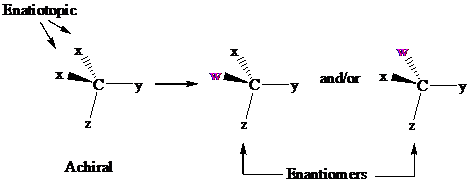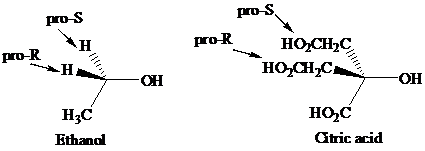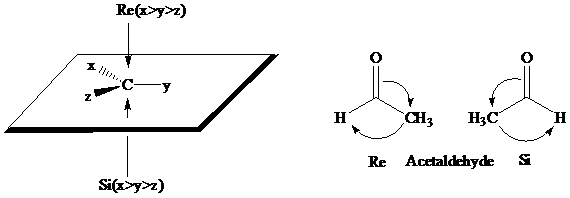
Consider two chemical changes: one occurring at a tetrahedral

Both transformations convert C in each achiral reactant to a chirality center in the product. The two achiral reactants are classified as prochiral. C is a prochiralitycenter in
In achiral molecules with tetrahedral prochiralitycenters, substitution of one of the two x groups by w gives the enantiomer of the product that results from substitution of the other. The two x groups occupy mirror-image sites and are enantiotopic.

Enantiotopic groups are designated as pro-R or pro-S by a modification of Cahn–Ingold– Prelog notation. One is assigned a higher priority than the other without disturbing the priorities of the remaining groups, and the R,S configuration of the resulting chirality center is determined in the usual way. If it is R, the group assigned the higher rank is pro-R. If S, this group is pro-S. Ethanol and citric acid illustrate the application of this notation to two prochiral molecules.

Citric acid played a major role in the development of the concept of prochirality. Its two

The stereochemical aspects of many enzyme-catalyzed reactions have been determined. Then enzyme alcohol dehydrogenase catalyzes the oxidation of ethanol to acetaldehyde by removing the pro-R hydrogen (abbreviated as HR). When the same enzyme catalyzes the reduction of acetaldehyde to ethanol, hydrogen is transferred to the Re face.

A method for the stereoselective synthesis of chiral

Re Re
Re Si
Si Si
Si Re
Want to see the full answer?
Check out a sample textbook solution
Chapter 4 Solutions
CAREY: ORGANIC CHEMISTRY
- Can someone draw a reaction mechanism of this reaction please I was told that the boc l alanine is deprotonated first and acts as the nucleophile attacking the EDCL and can you please show all the intermediates and side products and the water at the endarrow_forwardX- 22.5 d 33.0 d P17E.3 Two radioactive nuclides decay by successive first-order processes: → Y → Z (the quantities over the arrows are the half-lives in days). Suppose that Y is an isotope that is required for medical applications. At what time after X is first formed will Y be most abundant?arrow_forwardUse solubility rules to complete balance molecular equations, and provide total and net ionic equations. Silver Nitrate and Iron(III) Nitrate Copper(II) Sulfate and Ammonium Chloride Copper(II) Sulfate and Magnesium Chloride NH₄Cl(aq) + MgCl₂(aq) → NH₄Cl(aq) + Fe(NO₃)₃(aq) → NH₄Cl(aq) + BaCl₂(aq) →arrow_forward

 Chemistry: The Molecular ScienceChemistryISBN:9781285199047Author:John W. Moore, Conrad L. StanitskiPublisher:Cengage Learning
Chemistry: The Molecular ScienceChemistryISBN:9781285199047Author:John W. Moore, Conrad L. StanitskiPublisher:Cengage Learning Organic Chemistry: A Guided InquiryChemistryISBN:9780618974122Author:Andrei StraumanisPublisher:Cengage Learning
Organic Chemistry: A Guided InquiryChemistryISBN:9780618974122Author:Andrei StraumanisPublisher:Cengage Learning


